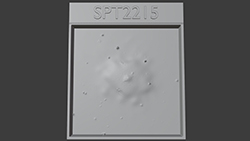CXC Home | Search | Help | Image Use Policy | Latest Images | Privacy | Accessibility | Glossary | Q&A
1
X-ray, Radio, & Optical Images of SPT-CL J2215-3537Credit: X-ray: NASA/CXC/MIT/M. Calzadilla; UV/Optical/Near-IR/IR: NASA/STScI/HST; Image processing: N. Wolk
SPT-CL J2215-3537 (SPT2215 for short) is the most distant “relaxed” cluster of galaxies ever found, meaning that it shows no signs of having been disrupted by violent collisions with other clusters of galaxies. These images show X-rays from Chandra, which helped identify SPT2215 along with other telescopes, and data from Hubble. Before this, astronomers were not sure relaxed clusters existed at this epoch of the universe, because they are usually still merging with other clusters or groups of galaxies as they increase in size.
2
3D Printable Files: SPT-CL J2215-3537 (3D Print Credit: NASA/CXC/A. Jubett, using software by Tactile Universe/N. Bonne & C. Krawczyk & Blender)
This tactile plate features a distant galaxy cluster known as SPT2215.
The galaxy cluster resembles a raised cloud with a raised peak at its
core. The cluster is set against the emptiness of space, which is dotted
with raised pinpoints of light. A combination of X-ray, ultraviolet,
optical, and infrared information was used to create the plate.
The raised cloud represents X-ray gas observed by Chandra. The cloud is uniform in texture. Over time, galaxy clusters often merge or collide. These collisions cause disturbances and sharp features in a cluster’s gas. When a cluster takes on a smooth, calm structure, as found here in SPT2215, it indicates that no such collisions have occurred for a very long time. Astronomers call these galaxy clusters “relaxed”.
The hazy bump at the heart of the cloud represents a massive central galaxy with a large amount of star formation. This central galaxy is quite isolated within the raised gas cloud. There are relatively few nearby specks of light near the central galaxy, and none protrude as much or are as large.
The raised cloud represents X-ray gas observed by Chandra. The cloud is uniform in texture. Over time, galaxy clusters often merge or collide. These collisions cause disturbances and sharp features in a cluster’s gas. When a cluster takes on a smooth, calm structure, as found here in SPT2215, it indicates that no such collisions have occurred for a very long time. Astronomers call these galaxy clusters “relaxed”.
The hazy bump at the heart of the cloud represents a massive central galaxy with a large amount of star formation. This central galaxy is quite isolated within the raised gas cloud. There are relatively few nearby specks of light near the central galaxy, and none protrude as much or are as large.
Return to: Unexpectedly Calm and Remote Galaxy Cluster Discovered (July 20, 2023)






